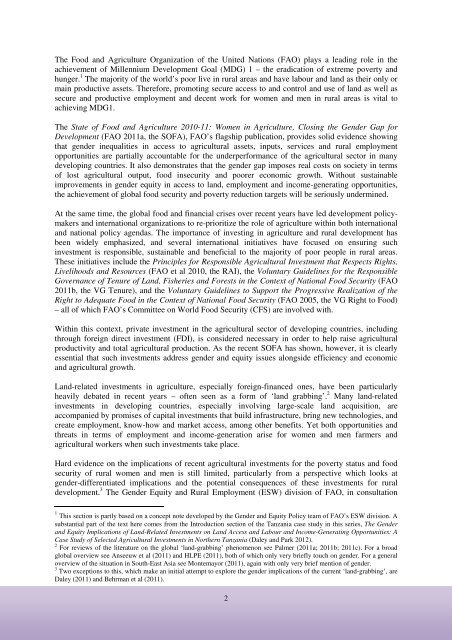6gEvuX
6gEvuX
6gEvuX
Create successful ePaper yourself
Turn your PDF publications into a flip-book with our unique Google optimized e-Paper software.
The Food and Agriculture Organization of the United Nations (FAO) plays a leading role in theachievement of Millennium Development Goal (MDG) 1 – the eradication of extreme poverty andhunger. 1 The majority of the world’s poor live in rural areas and have labour and land as their only ormain productive assets. Therefore, promoting secure access to and control and use of land as well assecure and productive employment and decent work for women and men in rural areas is vital toachieving MDG1.The State of Food and Agriculture 2010-11: Women in Agriculture, Closing the Gender Gap forDevelopment (FAO 2011a, the SOFA), FAO’s flagship publication, provides solid evidence showingthat gender inequalities in access to agricultural assets, inputs, services and rural employmentopportunities are partially accountable for the underperformance of the agricultural sector in manydeveloping countries. It also demonstrates that the gender gap imposes real costs on society in termsof lost agricultural output, food insecurity and poorer economic growth. Without sustainableimprovements in gender equity in access to land, employment and income-generating opportunities,the achievement of global food security and poverty reduction targets will be seriously undermined.At the same time, the global food and financial crises over recent years have led development policymakersand international organizations to re-prioritize the role of agriculture within both internationaland national policy agendas. The importance of investing in agriculture and rural development hasbeen widely emphasized, and several international initiatives have focused on ensuring suchinvestment is responsible, sustainable and beneficial to the majority of poor people in rural areas.These initiatives include the Principles for Responsible Agricultural Investment that Respects Rights,Livelihoods and Resources (FAO et al 2010, the RAI), the Voluntary Guidelines for the ResponsibleGovernance of Tenure of Land, Fisheries and Forests in the Context of National Food Security (FAO2011b, the VG Tenure), and the Voluntary Guidelines to Support the Progressive Realization of theRight to Adequate Food in the Context of National Food Security (FAO 2005, the VG Right to Food)– all of which FAO’s Committee on World Food Security (CFS) are involved with.Within this context, private investment in the agricultural sector of developing countries, includingthrough foreign direct investment (FDI), is considered necessary in order to help raise agriculturalproductivity and total agricultural production. As the recent SOFA has shown, however, it is clearlyessential that such investments address gender and equity issues alongside efficiency and economicand agricultural growth.Land-related investments in agriculture, especially foreign-financed ones, have been particularlyheavily debated in recent years – often seen as a form of ‘land grabbing’. 2 Many land-relatedinvestments in developing countries, especially involving large-scale land acquisition, areaccompanied by promises of capital investments that build infrastructure, bring new technologies, andcreate employment, know-how and market access, among other benefits. Yet both opportunities andthreats in terms of employment and income-generation arise for women and men farmers andagricultural workers when such investments take place.Hard evidence on the implications of recent agricultural investments for the poverty status and foodsecurity of rural women and men is still limited, particularly from a perspective which looks atgender-differentiated implications and the potential consequences of these investments for ruraldevelopment. 3 The Gender Equity and Rural Employment (ESW) division of FAO, in consultation1 This section is partly based on a concept note developed by the Gender and Equity Policy team of FAO’s ESW division. Asubstantial part of the text here comes from the Introduction section of the Tanzania case study in this series, The Genderand Equity Implications of Land-Related Investments on Land Access and Labour and Income-Generating Opportunities: ACase Study of Selected Agricultural Investments in Northern Tanzania (Daley and Park 2012).2 For reviews of the literature on the global ‘land-grabbing’ phenomenon see Palmer (2011a; 2011b; 2011c). For a broadglobal overview see Anseeuw et al (2011) and HLPE (2011), both of which only very briefly touch on gender. For a generaloverview of the situation in South-East Asia see Montemayor (2011), again with only very brief mention of gender.3 Two exceptions to this, which make an initial attempt to explore the gender implications of the current ‘land-grabbing’, areDaley (2011) and Behrman et al (2011).2


